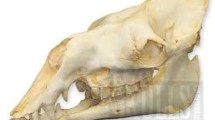Abstract.
Powdered tooth enamel heated at 400°C has been examined with electron paramagnetic resonance (EPR), electron-nuclear double resonance (ENDOR), and ENDOR-induced EPR (EIEPR) methods and compared with hydroxyapatite synthesized at high temperature. The EPR spectrum of the tooth enamel sample consists mainly of signals assigned to O− and CO2 − radicals, in contradistinction to the synthetic apatite sample, where signals of O− and CO3 3− were detected. The ENDOR results of heated enamel show that the O− radical is located at an A site and interacts with three unequivalent sets of 31P nuclei and two unequivalent protons. This supports the model proposed for synthetic apatite. The EIEPR results show that the 31P and 1H ENDOR resonances originate from both O− and CO2 − radicals and that the 23Na and 19F resonances originate only from a CO2 − radical located probably at the surface.
Similar content being viewed by others
Author information
Authors and Affiliations
Additional information
Received: 23 December 1996 / Accepted: 8 April 1998
Rights and permissions
About this article
Cite this article
Sadlo, J., Callens, F., Michalik, J. et al. Electron-Nuclear Double Resonance of Human Tooth Enamel Heated at 400°C. Calcif Tissue Int 63, 409–415 (1998). https://doi.org/10.1007/s002239900549
Published:
Issue Date:
DOI: https://doi.org/10.1007/s002239900549




